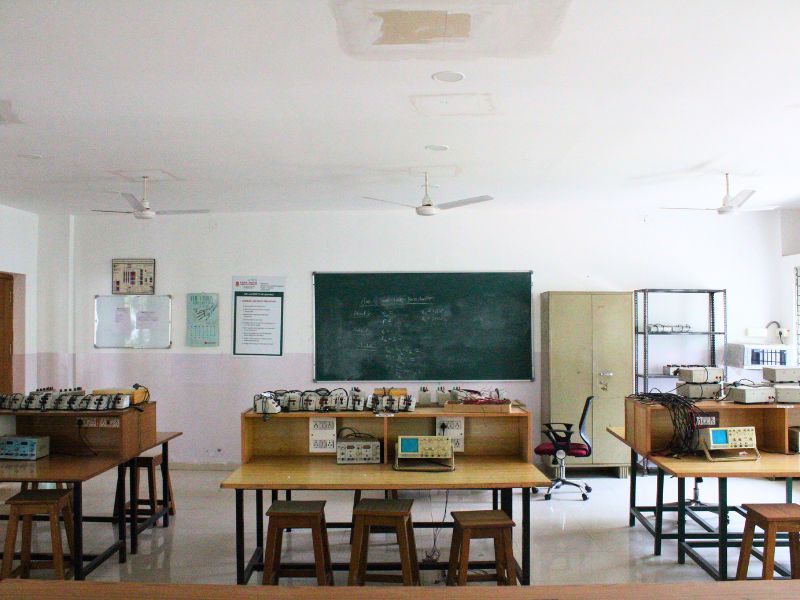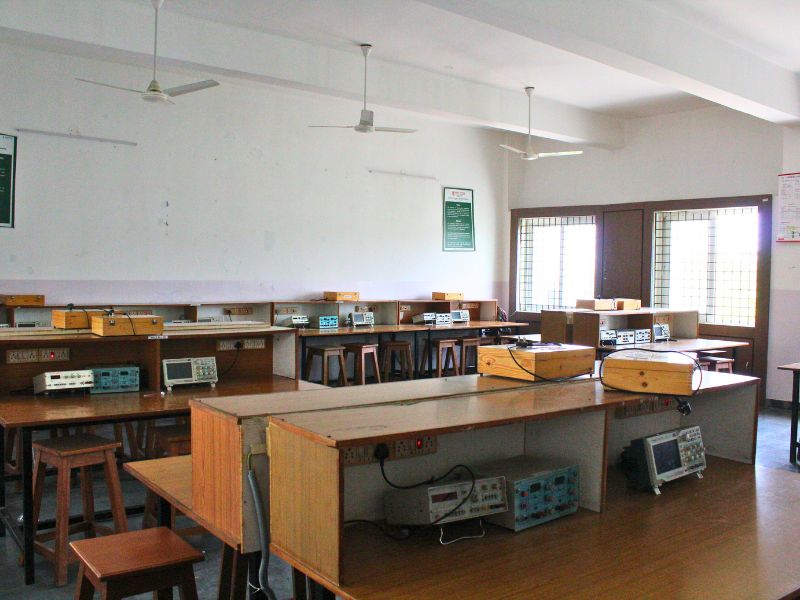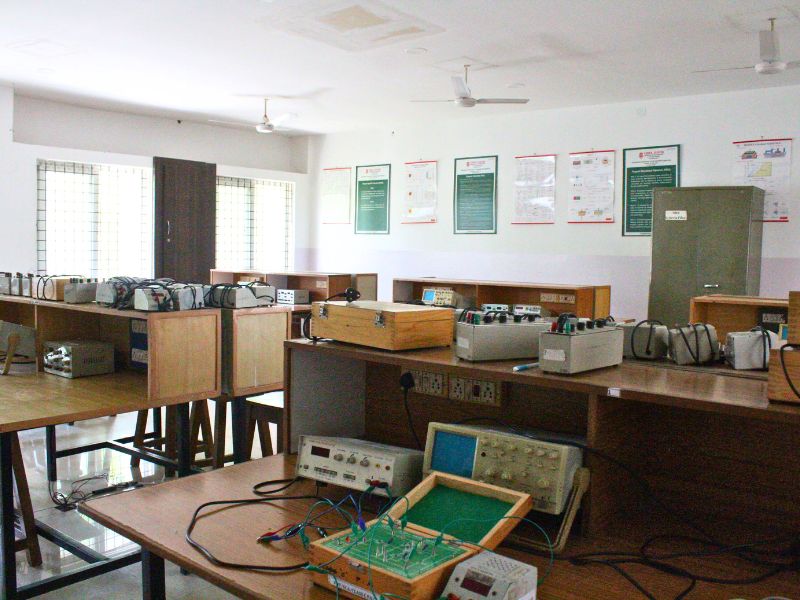Infrastructure
Infrastructure
The Department of Electronics & Communication Engineering has started its UG Program B.Tech(ECE)from the year 1999 with an intake of 40. At present the department has expanded to 240. M.Tech(ECE) was started in the year 2011 with an intake of 18. B.Tech(ECE) program first accredited by NBA in 2011. Later B.Tech(ECE) reaccredited in 2018. Presently the program is accredited by NBA under Tier-1 from 2022 for a period of three years. The Department of ECE is a center for activities, offering students the chance to actively participate in learning through workshops, seminars, certification programs, Hackathons, tech-fests, and research and development projects. The department provides a number of Technical Clubs to help students learn on their own and raise their knowledge levels. The department focuses on helping students to develop, improve, and expand the foundations of electronics and communication engineering in order to increase society’s intellectual capital. Year after year, 80% of our students have been placed. It makes every effort to produce seasoned engineers. A team of knowledgeable instructors, a hands-on learning method, and an emphasis on research have made the department known as one of the best for Electronics and Communication Engineering.
Laboratories
EDC Lab, II yr-I sem
Description:This lab is offered to B.Tech students and it is specially designed and developed for the students to observe the characteristics of various electronic devices. This lab is well provided with equipment like Cathode Ray Oscilloscopes (CRO), Digital Oscilloscopes, Regulated DC power supplies (RPS), Function Generators and Digital and Analog meters of a wide range. This lab gives practical observation on different basic applications of electronic devices. This gives a good foundation on electronic devices to the students in the initial years.
Outcome of the Lab:
At the end of the semester the student will handle any basic level electronic circuits. We also encourage students to take mini projects by providing them with the required components.
BS Lab,II yr-I Sem
Description:Basic Simulation Lab Provides the Generation, operation, transforms and sampling on signals, properties signals on systems. It show case the application of correlation, different transforms and understands the location of poles and zeros on S plane, Z plane to assess the stability of systems..
Outcome of the Lab:The students will understand how the noise will generate and removal of noise by using some predefined functions or functions written by them. It also enhances the environment to use tool boxes like GUI, SIMULINK etc
ADC Lab,II yr-II Sem
Description:Analog and Digital Communication laboratory provides depth knowledge about the analog and digital Communication components and in analyzing the analog and digital Communication equipment. The laboratory exercises are designed to give students ability to design, build, and analyze the components. The course uses Analog and Digital Communication modulation and demodulation setup. A key part of the Analog and Digital Communication laboratory experience is to learn how to use Analog and Digital Communication equipment to observe modulation and demodulation of a signal, measurements of amplitudes, time period, gain and conversion of signals. Modulation and demodulation parameters of analog and digital communication components are defined and used to characterize devices and system behavior
Outcome of the Lab:Student will be able gain knowledge in different Analog and Digital Communication Systems, Compare the characteristics of various Analog and Digital modulation schemes and analyze their performances, Develop various analog and digital modulation and demodulation systems.
APC Lab,II yr-II Sem
Description:This laboratory course builds on the lecture course “Electronic circuit analysis” and “pulse circuits” which is mandatory for all students of electronics and communication engineering. The course aims at practical experience with the characteristics and theoretical principles of linear and non linear devices and pulse circuits
Outcome of the Lab:Students can analyze and Design various amplifiers and its characteristics, various oscillators, create the different oscillations and timing circuits using multivibrators and can identify the applications of UJT.
AC Lab,III yr-I Sem
Description:Analog Communication Laboratory provides depth knowledge about the AC components and it is also useful for the analysis of signals in both analog and digital. The AC Laboratory exercises are to provide the understanding of signal transmission characteristics in the form of Amplitude, Frequency modulation, Sampling, Sampling rate, Multiplexing system, Noise calculations. The students will have an understanding of the concepts involved in transmission and reception of the analog signals and characteristics of the components.
Outcome of the Lab:The students will be able to understand different modulation and demodulation techniques. Develop the ability to compare and contrast the strengths and weaknesses of various modulation techniques.
LDICA Lab,III yr-I Sem
Description:
This laboratory course builds on the lecture course “Linear and digital IC Application” which is mandatory for all students of electronics and communication engineering. Integrated circuits are the present state of art of IC Technology. It is one of the core areas of ECE and constitutes the largest applications in use today. IC Technology has entered into every part of today’s world. This laboratory consists of linear experiments, digital IC experiments. Today, a single chip can contain tens of millions of transistors and can be programmed to create a system –on-a-chip –that, using technology of past, would have required hundreds of discrete chip containing millions of individual gates & flip-flop.
Outcome of the Lab:
This laboratory is intended to make students understand the use of different linear and digital IC.In this laboratory the student will become familiar with various linear ICs such as μA741 (Op-Amp), SE/NE 555(Timer), IC 723(Voltage Regulator) and IC 565(PLL) . They will understand the applications of the μA741 operations amplifier like adder, subtractor and comparator etc., the various applications of SE/NE 555 like Astable and Monostable operations. In addition to the above they will become familiar with various voltage regulators using IC 723. Second part student will know the functionality of the various 74 XX series TTL ICs such as D Flip-flop (74LS74), Decade counter (74LS90), 4-bit Magnitude comparator(74LS85), multiplexer ,T ,D flip flops and also design varies functions using 74XX IC’s.
MPMC Lab,III yr-II Sem
Description:This course introduces the assembly language programming of 8086 and 8051 microcontroller. it gives a practical training of interfacing the peripheral devices with the 8086 microprocessor. The course objective is to introduce the basic concepts of microprocessor and to develop in students the assembly language programming skills and real time applications of Microprocessor as well as microcontroller.
Outcome of the Lab:
After completing this course, the student will be able to:
- Apply the fundamentals of assembly level programming of microprocessors.
- Build a program on a microprocessor using instruction set of 8086.
- Summarize the concepts of Assembly level language programming and its applications.
- Develop the assembly level programming using 8086 instruction set.
- Analyze abstract problems and apply a combination of hardware and software to address the problem
- Contrast how different I/O devices can be interfaced to processor and will explore several techniques of interfacing.
- Experiment with standard microprocessor interfaces including GPIO, serial ports, digital-to-analog converters and analog-to-digital converters
- Make use of standard test and measurement equipment to evaluate digital interfaces.
DSP & ECAD Lab Lab,III yr-II Sem
Description:
This lab is to familiarize the students with MATLAB Environment. To learn Fourier Transform Concepts also how to design FIR filters & IIR filters and Demonstrate their abilities towards DSP processor based implementation of DSP system.
ECAD environments provide the tools for generating a physical representation of the integrated circuit from a high-level description. Traditionally, the designer starts with a schematic representation at a transistor or logical level, but due to the huge complexity of modern integrated circuits the trend is to use higher ones, such as in Hardware Description Languages (HDLs).
Xilinx ISE is a software tool produced by Xilinx for synthesis and analysis of HDL designs
Outcome of the Lab: After studying this course the students would be able to understand the Experiment concepts of DSP and its applications using MATLAB Software and they can able to generate Sinusoidal signal through filtering. can able to Calculate and Plot DFT / IDFT of given DT signal. Research people also using this DSP LAB concepts for various applications of DSP.
By using xilinxTool student able to synthesize (“compile”) their designs, perform timing analysis, examine RTL diagrams, simulate a design’s reaction to different stimuli, and configure the target device with the programmer. In our Lab, the scope is limited to design and analyze the design using test benches & simulation.
ESD Lab,IV yr-ISem
Description:
Design of microcontroller-based embedded systems; interfacing from hardware and software perspective; and applications, including audio, data acquisition, and communication systems.
Outcome of the Lab: After the successful completion students should be able to design embedded systems include hardware/software interfaces for devices like ADC Potentiometer, Analog serial plotter, Accelerometer sensor, Serial port communication, touch sensor. Furthermore, students will be able to perform Radio-frequency transmission and plotting LDR and temperature sensor operation using FRDM kit
MW & DC,IV yr-ISem
Description:
Microwave Engineering laboratory provides depth knowledge about the Microwave components and in analyzing the microwave equipment’s. The laboratory exercises are designed to give students ability to design, build, and analyze the components. The course uses Microwave bench setup. A key part of the microwave laboratory experience is to learn how to use microwave test equipment to make measurements of power, frequency, S parameters, SWR, return loss, and insertion loss. Scattering parameters of microwave components are defined and used to characterize devices and system behavior.
Digital Communication laboratory provides depth knowledge about the Digital Communication components and in analyzing the Digital Communication equipment. The laboratory exercises are designed to give students ability to design, build, and analyze the components. The course uses Digital Communication modulation and demodulation setup. A key part of the Digital Communication laboratory experience is to learn how to use Digital Communication equipment to observe modulation and demodulation of a signal, measurements of amplitudes, time period, gain and conversion of signals. Modulation and demodulation parameters of digital communication components are defined and used to characterize devices and system behavior.
Outcome of the Lab:
The students will have an understanding of the concepts involved in transmission and reception of the microwave signals, characteristics of components.
The students will have an understanding of the concepts involved in transmission and reception of the digital signals and characteristics of the components.
M.Tech Digital System Design with FPGAs la I-I Sem
Description:
This lab provide the tools for generating a physical representation of the integrated circuit from a high-level description. Traditionally, the designer starts with a schematic representation at a transistor or logical level, but due to the huge complexity of modern integrated circuits the trend is to use higher ones, such as in Hardware Description Languages (HDLs).Xilinx ISE is a software tool produced by Xilinx for synthesis and analysis of HDL designs.On the other hand, this lab provides the knowledge of various digital design using CMOS technology on LTSPICE software
Outcome of the Lab:
- Students can gain adequate knowledge in HDL coding while realizing logic gates.
- Students able to understand different structures of coding on different kind of adders.
- Students able to understand the clock distributions in sequential circuits.
- Students able to load the HDL program on FPGA/CPLD boards
- Students able to understand the importance of CMOS inverter
M.Tech System Design with Embedded Linux lab I-I Sem
Description: Verification of embedded system designs and interfaces in Linux environment and perform the real time environment models.
Outcome of the Lab:
- Familiarity of the embedded Linux development model.
- Write, debug, and profile applications and drivers in embedded Linux.
- Create Linux BSP for a hardware platform
M.Tech ARM Microcontroller Lab I-II Sem
Description:Design of microcontroller-based embedded systems; interfacing from hardware and software perspective; and applications, including ARM processor. This lab demonstrate the delay constraints on IDE environment.
Outcome of the Lab:
- Students able to understand the selection procedure of processors in the embedded domain.
- Expected to visualize the role of Real time Operating Systems in Embedded Systems
- Students can gain knowledge about the basic concepts of embedded systems.
- Students able to implement arithmetic operation on ARM processor.
- Students able to demonstrate time delay constraints on IDE environment.
M.Tech Embedded and IOT Sensor lab I yr-II Sem
Description:.This lab is specially designed and developed for the students to study the advanced embedded system. The lab is well equipped with keil software and having FPGA boards for embedded system development. The lab gives hand on experience on embedded system development and how to debug and prototype. This lab provides resources to build real time embedded system and working with various protocols
Outcome of the Lab:
- Students able to understand the selection procedure of processors in the embedded domain.
- Expected to visualize the role of Real time Operating Systemin Embedded Systems
- Students can gain knowledge about the basic concepts of embedded systems.
- Students able to understand interfacing programs
- Students can design combinational and sequential circuits on FPGA boards.

ECE lab -I

ECE lab -3

ECE lab -2





















